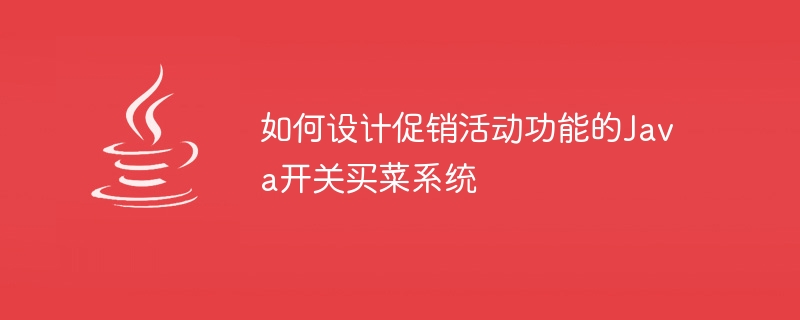
How to design a Java switch grocery shopping system with promotional activities
With the rapid development of e-commerce, people are increasingly inclined to online shopping and purchase various products. A variety of products, including fresh ingredients. In order to meet the needs of consumers, many companies have developed food shopping systems to facilitate users to purchase fresh ingredients anytime and anywhere. As a common promotional method, promotional activities play an important role in attracting consumers and increasing sales. This article will introduce how to design a Java switch grocery shopping system to have the function of promotional activities.
1. System requirements analysis
Before designing the Java switch grocery shopping system, we need to conduct a requirements analysis on the system. The following are some common system requirements:
- User requirements:
- Users can browse the product catalog and select the products they need to purchase.
- Users can add products to the shopping cart and pay for shopping.
- Users can view order details and order status.
- Merchant requirements:
- Merchant can add products and edit product information.
- Merchant can manage orders, including receiving orders, shipping, canceling orders and other operations.
- System requirements:
- The system needs to protect user privacy and payment security.
- The system needs to be able to handle a large number of concurrent requests.
2. How to design the promotion function
Before designing the promotion function, you first need to define the type and rules of the promotion. For example, you can set up promotion methods such as full discounts, discounts, buy one get one free, etc. Next, we implement the promotion function through the following steps:
- Database design:
Create a promotion table in the database to store promotion-related information, including activities Name, activity type, applicable products, activity time, promotion rules, etc.
- Backend development:
In the background development, we need to write the corresponding Java code to implement the promotion function. First, you need to write an activity management module, including functions such as activity addition, editing, and deletion. In the product management module, you need to add an interface to query promotional activities and calculate product prices based on activity rules.
- Front-end development:
In the front-end page, promotion information needs to be displayed so that users can clearly understand the current promotions. At the same time, when the user selects the product, the promotional price needs to be calculated in real time and displayed in the shopping cart.
- Use a switch to control the enabling and disabling of activities:
In order to better control promotional activities, you can use a switch to identify whether the current activity is enabled. In this way, when you need to disable an activity, you only need to turn off the switch without modifying the specific implementation logic of the activity.
3. System Optimization
In order to improve the performance and user experience of the system, we can perform the following optimizations:
- Use caching technology:
You can store products Information, promotion information and other frequently accessed data are cached in memory to reduce database read and write operations and improve system performance.
- Asynchronous processing:
You can use the message queue to process some time-consuming operations asynchronously in the background to avoid blocking requests.
- Distributed deployment:
The system can be split into multiple microservices and deployed in a distributed manner to improve the scalability and fault tolerance of the system.
Conclusion:
Through the design and optimization of the above steps, we can implement a powerful and excellent Java switch grocery shopping system to meet the needs of users to purchase goods and provide rich promotions Activity function. At the same time, the optimized system can provide a better user experience and improve system stability and performance. I hope this article will be helpful to readers who are designing a Java switch grocery shopping system with promotional functions.
The above is the detailed content of How to design a Java switch grocery shopping system with promotional activities function. For more information, please follow other related articles on the PHP Chinese website!






